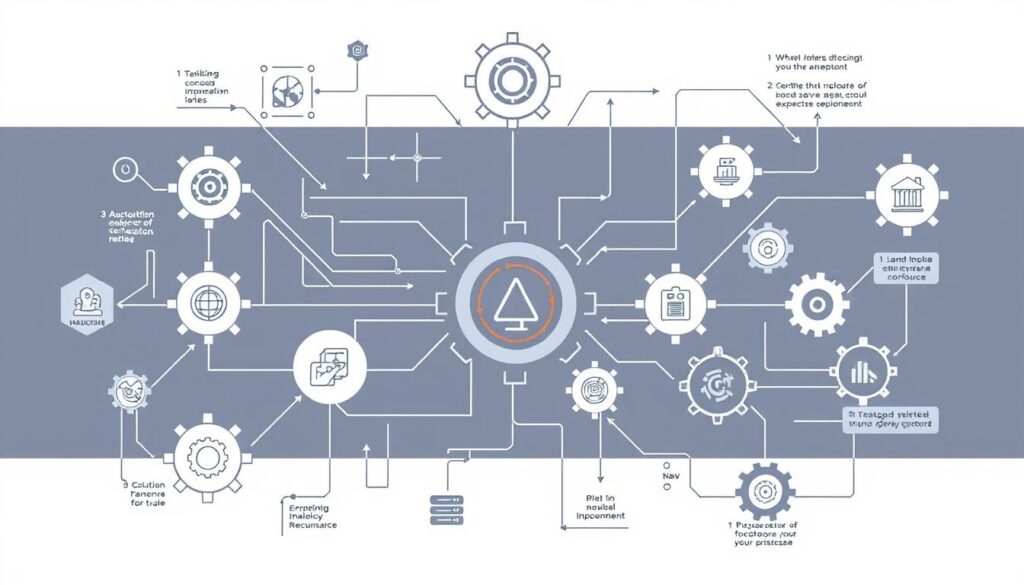In today’s business world, efficiency through automation is key to staying ahead. Juan Perez, EVP and CIO of Salesforce, says that implementing automation strategies is critical. It is essential for making businesses nimble and improving team performance. Automation changes how we work by saving time on everyday jobs. This lets companies focus more on creating value and improving what customers go through.
Data shows how important automation is for businesses today. It helps make quicker decisions, reduce mistakes, improve compliance, and balance work and life better. This leads to happier employees in a tough job market. It also shows the real perks of automated strategy execution. Companies like Vonage have seen quick benefits. They have made some tasks, like managing quotes, much faster. This supports growth and cuts down on mistakes.
Key Takeaways
- Adopting automation strategies is essential for business agility and enhanced employee performance.
- Automation allows valuable resources to be reallocated from repetitive tasks to strategic initiatives.
- By implementing automated solutions, businesses can expect rapid process acceleration and error reduction.
- Ensuring data security and compliance is critical during the automation implementation process.
- Employee empowerment through adequate training ensures the success of new automated systems.
- Continuous monitoring is necessary to realize and sustain the benefits of automation over time.
- An innovative culture within an organization can drive successful automation adoption and ongoing improvement.
Understanding Automation Strategies
Businesses need to stay ahead in our fast-changing digital world. Automation’s role in corporate strategies has become crucial. Understanding this shift in basics and its impact is key.
Definition of Automation
Automation means using technology to do tasks without humans. Tasks once done by people are now handled by machines. Thanks to real-time data and artificial intelligence, automation improves productivity and learning capability. Experts like those at Salesforce say automation makes customer experiences better. It turns fixed operations into improving systems.
Importance in Today’s Business Environment
In today’s world, strategy automation is more important than ever. This is because of global challenges like inflation and supply chain issues. Creating a good process automation strategy is key for businesses. It helps save resources and improve customer relations. As automation technology gets better, companies focus more on using it to enhance operations.
The journey includes using new tech tools. It also involves imagining new ways of working and changing company structures. This supports ongoing improvement and better efficiency.

| Key Automation Focus | Importance |
|---|---|
| Cost Reduction | Essential for maximizing budget efficiency |
| Employee Engagement | Critical for internal buy-in and smooth transition |
| Strategic Implementation | Aligns with long-term business goals and vision |
| Technology Integration | Supports scalability and future growth |
| Cultural Shift | Facilitates an automation-centric workforce mindset |
The table shows different parts of an automation strategy. It’s not just about new tools. It’s also about creating a culture open to digital change. For businesses, using strategic automation helps them succeed in a competitive, tech-driven market.
Benefits of Implementing Automation
In today’s world, being efficient is key to business success. Learning to automate workflows and improving productivity through automating processes is vital. By using automation, companies can do tasks faster and improve their place in the market. Let’s look at the main advantages of using automation.
Increased Productivity
Automating routine tasks saves time for employees. This lets them do more important work. As a result, they are happier and more gets done.
Automation tools speed up high-volume tasks. They get rid of slow spots in the workflow. This makes everything move faster.
Cost-Effectiveness
Automation cuts down on the need for lots of manual work. This lowers labor costs and lets companies spend money on other important things. Also, it means less mistakes and wasted time. This saves money on fixing errors and avoids extra costs from not following rules.
Improved Accuracy
Automation is great at doing tasks the same way every time, which means fewer mistakes. This is especially important in fields like manufacturing. Automating things like following rules and keeping records can also reduce legal problems.

To sum up, using automation can make businesses more productive, save money, and work more accurately. These changes are about more than just saving money. They help companies work better and give more to their customers. As automation gets better, the future looks bright for businesses that use it well.
Key Areas for Automation in Business
Automating key business parts boosts efficiency and customer success. We will look at three main areas where automation adds great value.
Customer Relationship Management
In Customer Relationship Management (CRM), automating helps a lot. By using advanced systems like Salesforce, tasks like customer follow-ups become automated. This makes sure customers get consistent and personalized attention. Automation also helps predict what customers will need in the future. This leads to better business planning. Plus, mixing AI with CRM makes strategies more dynamic, improving satisfaction and keeping customers loyal.
Supply Chain Operations
Supply chain management gets a big boost from automation. It makes logistics, tracking, and orders more efficient. This reduces errors and speeds up processes, helping meet market needs fast and correctly. Better data analysis also comes with automation. This means smarter decisions that can lower costs and improve operations.
Human Resources Management
Human Resources Management (HRM) changes a lot with automation. Using systems for tracking applicants and managing payroll saves time. This lets HR focus more on growth and engaging employees. Automation makes HR tasks more timely and accurate. This boosts job satisfaction among employees.
To learn how automation can benefit your business and help with customer success, see this helpful Forbes article.
| Aspect | Impact of Automation | Percentage Improvement |
|---|---|---|
| Time to Close Books | Reduced from weeks to days | 88% |
| Error Reduction in Accounting | Significant reduction in human errors | 75% |
| Employee Satisfaction | Improved due to focus on strategic tasks | 90% |
| Customer Follow-ups Efficiency | Increased proactive customer interactions | 70% |
Automation not only makes operations better but also leads to growth and customer success. Using automated solutions in CRM, supply chain, and HR gives efficiency and an edge in the market.
Steps to Implement Automation Strategies
Starting with strategy automation is exciting and offers great benefits like efficiency through automation. It’s key to be methodical, making sure each step helps achieve business goals.
Assessing Current Processes
Automation begins by looking closely at how things are currently done. This step finds where delays or mistakes happen that automation can fix. For example, using Robotic Process Automation (RPA) can take over routine, daily tasks. This allows people to focus on more important, strategic work.
Choosing the Right Tools
After reviewing current processes, choosing the right tools is crucial. Simple form-based solutions let departments automate with little help from IT. But, for complex needs, advanced systems or AI tools might be better, despite being more expensive and harder to set up.
Training Employees
Training and helping employees adapt is essential for automation success. Everyone needs to learn how to use the new systems. This helps the whole organization get comfortable with automation, improving how well it’s adopted and used.
Talking about how automation fits with business goals during planning is also important. It ensures the tools work well with business strategy, leading to better communication and operation across departments.
| Process | Tool Type | Improvement Note |
|---|---|---|
| Task Scheduling | Low-code automation platforms | Reduces manual scheduling errors |
| Data Entry | Robotic Process Automation (RPA) | Enhances speed and accuracy |
| Resource Allocation | Advanced ERP Systems | Optimizes asset utilization |
| Customer Communication | AI-Driven Tools | Improves response time and personalization |
Achieving efficiency through automation is possible with the right strategy automation plan. This includes careful planning, picking suitable tools, and thoroughly training staff. By doing these things, a company can improve its operations and grow significantly.
Measuring the Success of Automation Strategies
Analyzing performance outcomes is key in mastering efficiency with automation. To succeed, we need actionable insights from close monitoring and measurement. It’s about seeing if our investment in automation really pays off by looking at different metrics.
Key Performance Indicators (KPIs)
To truly know if automation works, companies must watch the right KPIs. For example, by looking at ROI, businesses can see savings from less labor and fewer mistakes. This means automation is making things more efficient. Also, important KPIs like how fast a process runs, how much we’re using what we have, and how quickly tasks are done show if productivity is going up. Checking on customer and employee happiness can also show how automation is doing.
By looking at how happy customers are and their feedback, the effect of automated services becomes clear.
Continuous Improvement Techniques
Getting the most from automation means always trying to do better. This means keeping track of how things are going and making necessary changes. In software testing, we look at metrics to see if our automation tools are up to par. Teams compare how things were before and after automation, like how much time they save on certain tests. This shows the real benefits of automation.
In the community of automation users, the focus is on growing the network. This is done by looking at how often people contribute, attend meetings, and share resources. The goal is to build a culture that constantly improves automation tools for better success, even as things change.
FAQ
What is automation in the context of business strategy?
Automation in business means using tech to do tasks without people. It makes things more efficient and reduces mistakes. This lets workers focus on more important work.
Why is automation becoming critical in the current business environment?
Nowadays, businesses face tough challenges. Automation helps them stay competitive and quick. It cuts down on repetitive work, lowers mistakes, and speeds up decisions. This leads to happier customers and workers.
What are some of the primary benefits of implementing automation?
By automating, companies get more done and spend less. They also make fewer mistakes. Workers get to do more meaningful work, which makes them happier and might even keep them on the job longer.
In which business areas can automation have a significant impact?
Automation shines in CRM, supply chains, and HR. In CRM, it speeds up sales and personalizes customer contact with instant data. This automates the boring stuff, making things faster.
How should a company start implementing automation strategies?
Start by looking at your current processes to see what could be automated. Pick the right tools that fit your company’s size and needs. Then, train your employees and check the quality to make sure everyone’s ready for the new automated steps.
How can businesses measure the effectiveness of their automation strategies?
Check how well automation works by watching Key Performance Indicators (KPIs) and reviewing data. Always be ready to adjust your strategy. This keeps your operations smooth and your company competitive.



